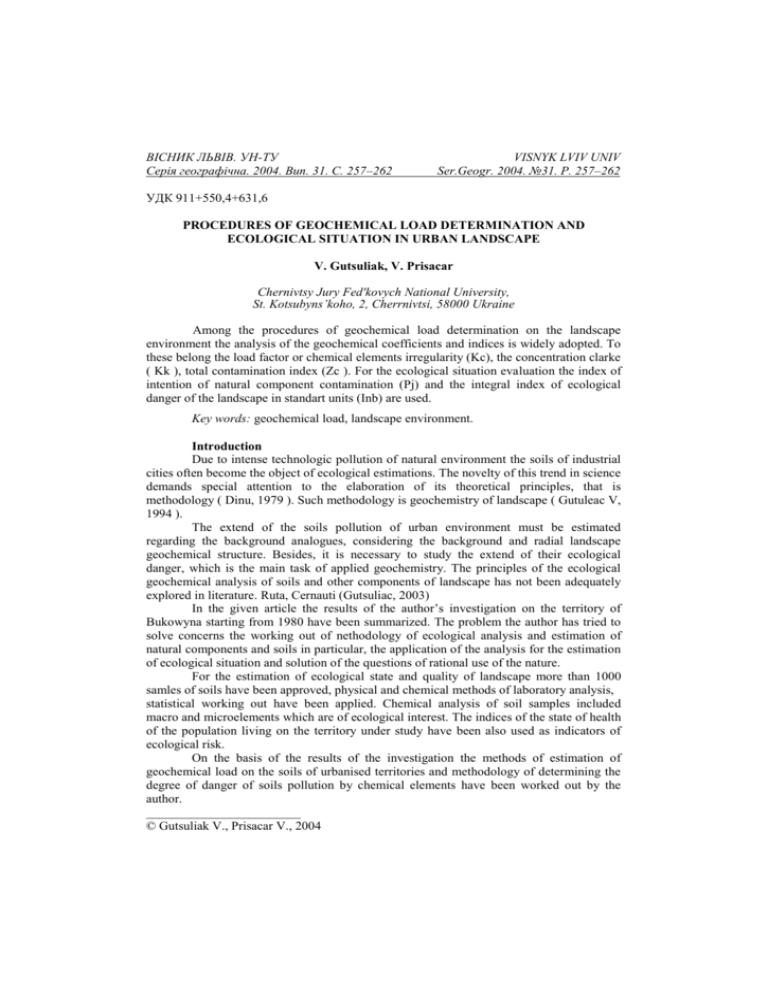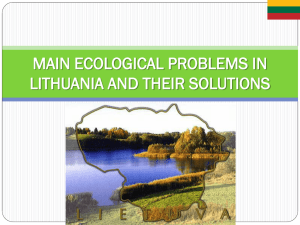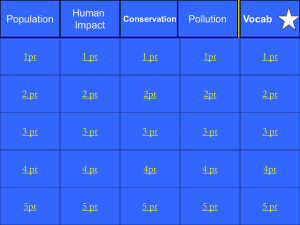УДК 911+550,4+631,6
advertisement

ВІСНИК ЛЬВІВ. УН-ТУ Серія географічна. 2004. Вип. 31. С. 257–262 VISNYK LVIV UNIV Ser.Geogr. 2004. №31. Р. 257–262 УДК 911+550,4+631,6 PROCEDURES OF GEOCHEMICAL LOAD DETERMINATION AND ECOLOGICAL SITUATION IN URBAN LANDSCAPE V. Gutsuliak, V. Prisacar Chernivtsy Jury Fed'kovych National University, St. Kotsubyns’koho, 2, Cherrnivtsi, 58000 Ukraine Among the procedures of geochemical load determination on the landscape environment the analysis of the geochemical coefficients and indices is widely adopted. To these belong the load factor or chemical elements irregularity (Kc), the concentration clarke ( Kk ), total contamination index (Zc ). For the ecological situation evaluation the index of intention of natural component contamination (Pj) and the integral index of ecological danger of the landscape in standart units (Inb) are used. Key words: geochemical load, landscape environment. Introduction Due to intense technologic pollution of natural environment the soils of industrial cities often become the object of ecological estimations. The novelty of this trend in science demands special attention to the elaboration of its theoretical principles, that is methodology ( Dinu, 1979 ). Such methodology is geochemistry of landscape ( Gutuleac V, 1994 ). The extend of the soils pollution of urban environment must be estimated regarding the background analogues, considering the background and radial landscape geochemical structure. Besides, it is necessary to study the extend of their ecological danger, which is the main task of applied geochemistry. The principles of the ecological geochemical analysis of soils and other components of landscape has not been adequately explored in literature. Ruta, Cernauti (Gutsuliac, 2003) In the given article the results of the author’s investigation on the territory of Bukowyna starting from 1980 have been summarized. The problem the author has tried to solve concerns the working out of nethodology of ecological analysis and estimation of natural components and soils in particular, the application of the analysis for the estimation of ecological situation and solution of the questions of rational use of the nature. For the estimation of ecological state and quality of landscape more than 1000 samles of soils have been approved, physical and chemical methods of laboratory analysis, statistical working out have been applied. Chemical analysis of soil samples included macro and microelements which are of ecological interest. The indices of the state of health of the population living on the territory under study have been also used as indicators of ecological risk. On the basis of the results of the investigation the methods of estimation of geochemical load on the soils of urbanised territories and methodology of determining the degree of danger of soils pollution by chemical elements have been worked out by the author. ________________________ © Gutsuliak V., Prisacar V., 2004 258 V. Gutsuliak, V. Prisacar As it known, due to the anthropic activity many natural soils have changed in Anthrosols, especially in the urban areas. This phenomenon is due to the industry development, stretching of dwelling space, improvement of agricultural technology etc. 1. Geochemical analysis of the landscape As a result of owing to the accentuated technogenic pollution of soils, the industrial cities become more and more frequently objectives of ecological assessment. The actual state of this scientific concern requires the preparation of its methodological basis. Such a methodology is offered by the landscape geochemistry. The concrete methods of this science, its terminology has an important role. In cities, as well as in natural landscapes, it is necessary toinvestigate the water and air migration, and biological flow of atoms. At the same time, it should be taken into account the fact that the cities are constituded of different landscape ( and geochemical ) systems – residential, industrial, recreational etc. that have a certain functional role. The geochemical analysis of Anthrosols should be fulfilled having in namely view three aspects: study of chemical elements migration, and energetic and informative characteristics of these processes. The analysis of balance degree regarding the urban landscape is of a particular importance. The city is a very unbalanced system, much more unbalanced than the natural landscapes. The urban landscape abounds in free energy. The feedback are characteristic for urban systems, but those positive exceed the negative ones. They permanently determine the development rhythm of soils towards an unsuitable (environmental pollution) direction. A problem of optimizing the urban soils consists in amplifying the negative feedback that leads to their self-organization. To study the geochemistry of cities, it is necessary to apply the Le-Satelle’s principle, that is the centralization principle (determination of structural centre of urban landscape, key of problems controlling the processes). When the geochemical methods are used to investigate the urban soils, it is important to know that the technogenic current of substance are dispersed, accumulated and transformed by means of natural components. To establish the connections between the above mentioned processes, it is necessary to analyse the chemical composition not only of soils but also of bottom sediments, snow layers and vegetation as well as of natural factors of landscapes pollution and self-cleaning. The assessment regarding the pollution degree of urban environmental components should be made taking into account the lateral and radial background structure from landscape and geochemical viewpoint. Also, the spatial structure of pollution and the differentiation of territory, according to the ecolofical risks, should be studied, that being a fundamental problem of the applied geochemistry. The natural and anthropic factors play an important role in the formation of the ecological state (pollution and self-cleaning). Among the climatic factors, two groups are singled out: • those determining the metabolism intensity of technogenesis products (sum of solar radiation, ultraviolet, thermic and ozone regime of atmosphere – the ozone contributes to oxidation); • those determining the intensity of movement and accumulation of technogenesis products (mean annual wind speed, number of calm days, misty days, precipitation). The PROCEDURES OF GEOCHEMICAL LOAD DETERMINATION … 259 climatic maps of city are prepared according to each index, and also a synthetic map of climatic factors is prepared. Among the main geological and morphological factors the following are singled out: soil erosion degree and factor that determine the intensity and character of the distribution of the technogenesis products in soil; level of ground water table and its protection degree by the impermeable horizons, particle size distribution of parent materials as well as their mineralogy and chemical properties etc. An important factor determining the landscape stability conserning the pedogeochemical pollution is the soil capacity to play the buffer role. The movement of active pollutants is determine by soil absorption capacity (depending on the particle size distribution and humus content), alkalino-acid and redox condition (Table 1). Table 1. Mobility of biochecally active elements of technogenesis in soils according to the alkalino-acid and redox conditions Conditions Alkalino - acid Redox Acid Oxidation Acid Reduction Slighty acid and neutral Oxidation Slighty acid and neutral Reduction Alkaline Oxidation Very long Mn, Mo As, Se Mo, V Pb Pb Mo Pb Co Mobility Moderate Pb, Ag, Se Co, Ni, Cu, V Pb,Cd Co, Ni, Cu,Zn, Cd Intensive Co, Mn Cu, Zn As, Se Mo,Cu,Co,Ni,Cr Zn,V Cd,As,Se V,Cu,Zn,Co,Ni,Cr Cd,Cu,Zn As,Se V,Cr,Mo ٭Numerator – very toxic elements; denominates – less toxic elements. 2. Procedures for evaluation of geochemical effects Among the procedures to assess the geochemical weight on soils there are frequently the concentration coefficient or the anomaly coefficient of chemical elements (Kc), concenration klark (Kk), concise pollution indices (Zc). When the sum of anthropic weight (influence) exceeds the possibility, acute ecological situations occur. The concentration coefficient is the ratio between the real quantity of substance in the natural component and its background quantity (Kk) – as compared to its klark in lithosphere. Zc is the sum of concentration coefficients of chemical substances. The number of elements totaled depends on their ecological value, analytical results etc. ( frequently 260 V. Gutsuliak, V. Prisacar about 15 elements are totalled, especially those of the heavy metals). The formulas to calculate the concentration degree and the soil pollution intensity degree, as well as other natural components are presented below. The consentration coefficient of a chemical element (i) as compared to its natural background (klark) is: Kci = Ci / Cf Where: Ci – concentration of element in soils of landscape; Cf – its natural background (klark – concentration); The concentration klark (Kk) of an element is: Kki = Ci / Ki Where: Ki – klark, that is mean quantity of an element in the terrestrial crust (per cent mass). The concise soil pollution (Zc) is: Zcj = ∑Kci – (n-1) Where: n – number of chemical elements ( the elements having Kci > 1 are totalized, j – landscape component. The concise index of concentration klarks of elements in the natural component is: Zkj = ∑Kki – (n-1). 3. Determination of pollution risk Determination of pollution risk degree of soils with chemical substances. Hygienically, the risk of landscape pollution is determined by the level of the possible negative influence of this pollution on environment (whose components have a direct contact – air, water, soils, food products) and man, respectively. The basic criterion for hygienic assessment of the pollution risk is the maximum allowable limit (MAX) of chemical substances in landscape components. The influence of pollution on human health is determined by using the coefficient of chemical element risk (Kpi). This is determined by the ratio between the quantity of substance in components of landscape, which is analysed, and the maximum allowable limit (Kp = Ci / MAL). The concise pollution risk index is determined by the sum of Kp indices. To assess the of ecology state, the pollution intensity index (Pj) is also used. It is determined by the formula: Pj = ∑Kci Mj Where: Kci – concentration coefficient of chemical element (i); M – toxic value of chemical element (according to the risk class): Class I: > 4.1 Class II: 2.6 – 4.0 Class III: 0.5 – 2.5 Class IV: < 0.5 The use of above formula allows to take into account the ecological importance of soils and other components of landscape, the synergetic action of chemical elements that determine the conditions of people life and health. For instance, the landscape complexes in the central zone the Cernautzi city (Pj = 70) are threatened by a high risk, thus confirming the conclusion referring to the ecological pressure and the necessity to adopt some measures for improving the soils in the respective urban territories. The analysis of geochemical indices distribution, according to the above mentioned parameters (that are obtained after the approval of the natural components), PROCEDURES OF GEOCHEMICAL LOAD DETERMINATION … 261 reveals the spatial structure image regarding the pollution of soils in the dwelling territories (air, soils, water included) that constitutes the highest risk for human health. The selection of chemical factors to assess the pollution risk of landscapes is performed taking into account: 1. specificity of pollution sources determining the complex of pollution chemical elements ( Table 2 ); 2. priority of pollutants according to the risk level and the maximum allowable limit (MAL) of chemical substances ( Table 3 ); 3. environmental alkalino-acid conditions according to the water pH (strongly acid – 4, slightly acid – 4.6 – 5, neutral and slightly acid – 6.5 – 8.5, strongly alkaline > 8.5); 4. obstacle character of landscape component that influences the movement of chemical elements. The less characteristic the obstacle properties of landscape are the higher is the pollution risk, this affecting especially the landscapes with acid pH, a lowel soil humus content and a lighter texture. The character of land uses (localities, agricultural land areas, recreational areas etc.) When it is not possible to take into account all the chemical elements polluting the landscape, the assessment is made according to the most toxic elements, that is considering the most dangerous class. Conclusions Having employed geochemical factors, total indicator of pollution (Zc), intensive indicates of pollution (Pj), we estimated the ecological situation of antroposoils (antroposols).The landscape as a whole has been estimeded with the help of integral indicators of ecological danger (In). The anomalous integral indicator of ecological danger of soils which has been found out (In = 50) may be considered entirely as critical (the threshold), beyond which certain biological reactions of the organism are observed. Monitoring of the quality of the soils (and landscapes as a whole ) is the key condition of integral management of antroposoils ( antroposoluri). Table 2. Accumulation of chemical elements in soils of landscapes in the zone influenced by some industrial enterprises and other pollution sources Pollution sources Production types Industry, for construction of machines and processing metals Pollution sources Enterprises for processing metals Industry, for construction of machines and processing metals Enterprises for processing metals Manufacture of equipment for electromechanical industry. Manufacture of storage battery with lead Production types Concentration coefficient (Kc) 2 - 10 > 10 Nickel, Chromium, Lead, zinc Mercury, Tin, Copper, Concentration coefficient (Kc) 2 - 10 > 10 Nickel, Chromium, Lead, zinc Mercury, Tin, Copper Nickel, Cadmium Fertilisers Industrial waste water Cooper Antimony, zinc Lead, Zinc 262 V. Gutsuliak, V. Prisacar Table3. Ordination of chemical substances entering the soil from emmissions, leakage, wastes, according to the pollution level Class of risk degree I ( very dangerous ) II ( dangerous ) III ( moderately dangerous ) Chemical substance Arsenic, cadmium, mercury, lead, selenium, zinc, fluorine, benzopyrine Boron, cobalt, nickel, molybdenum, copper, antinomy, chromium Borium,vanadium, wolfram, manganese, strontium, acetophenon ________________________ 1. Dinu, V., 1979. Mediul inconjurator in viata omenirii contemporane (The environment in contemporary mankind life). 2. Gutuleac, V. N., 1994. Geochemistry of landscapes. Edit ., Cernauti, Ruta 82 pp. (Ukrainian langauage); 3. Гуцуляк В.М., 2003 Ландшафтна екологія : Чернівці,. (Gutuleac, V. N., 2003. Ecology of landscapes, Cernauti, Ruta 276). МЕТОДИЧНІ ПРИЙОМИ ВИЗНАЧЕННЯ ГЕОХІМІЧНОГО НАВАНТАЖЕННЯ ТА ЕКОЛОГІЧНОЇ СИТУАЦІЇ В УРБАНІЗОВАНИХ ЛАНДШАФТАХ В. Гуцуляк, В. Прісакар Чернівецький національний університет імені Юрія Федьковича, вул. Коцюбинського, 2, м. Чернівці, 58000 Україна Серед методичних прийомів (засобів) визначення геохімічного навантаження на ландшафтне середовище широке застосування має аналіз геохімічних коефіцієнтів і показників. Такими є коефіцієнт концентрації або аномальності хімічних елементів (Кс), кларк концентрації (Кк), сумарний показник забруднення (Zc). Для оцінки екологічної ситуації використовуються також показник інтенсивності забруднення природного компонента (Pj), який враховує ступінь токсичності хімічного елемента у відповідності до класу небезпечності, та інтегральний показник екологічної небезпечності ландшафту (Інб), в якому враховується транслокаційний показник шкідливості, виражений в умовних одиницях (для грунтів – 2, повітря – 3, грунтових вод – 4, біомаси – 5). Використання запропонованих показників дозволяє врахувати синергічну дію хімічних елементів–забруднювачів та екологічну значимість компонентів ландшафту. Ключові слова: геохімічне навантаження, ландшафтне довкілля. Стаття надійшла до редколегії 18.02.2004 Прийнята до друку 16.06.2004






